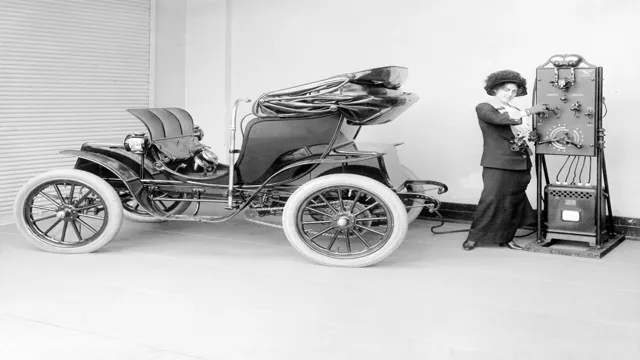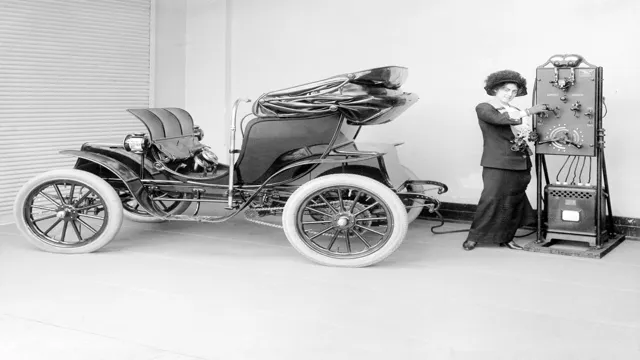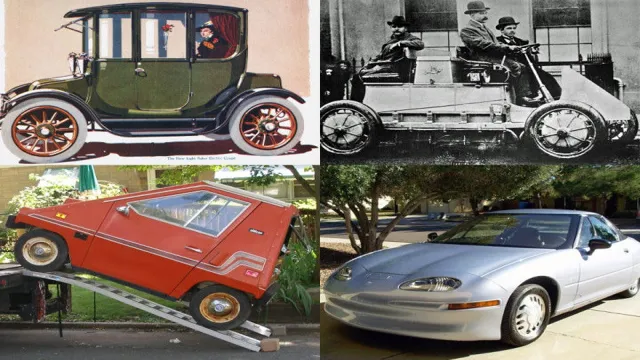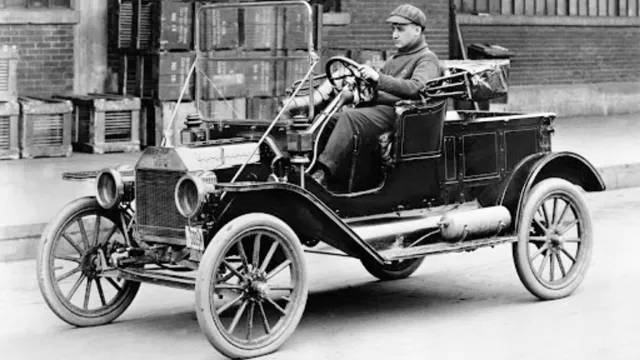Reviving the Past: Exploring the Fascinating History of Early Electric Cars
When we think of electric cars, we often picture sleek, modern vehicles powered by the latest technology. However, electric cars have been around much longer than we might think. In fact, the first electric cars were developed in the mid-19th century, long before gas-powered cars became popular.
Despite facing many challenges, these cars proved to be innovative and ahead of their time in terms of sustainability. Today, we’re taking a look at the history of early electric cars and how they have shaped the future of transportation as we know it.
Introduction
The history of early electric cars is an intriguing one, dating back to the 1800s when inventors were experimenting with electrically powered vehicles. Although these cars were not as popular initially, they provided an exciting alternative to steam and gasoline-powered engines. In the early 20th century, electric vehicles gained popularity as a cleaner mode of transportation, but ultimately lost out to gasoline-powered cars due to advancements in internal combustion engine technology and the mass production of gasoline cars.
However, over a century later, electric cars are once again becoming a driving force in the automobile industry as we seek cleaner, more eco-friendly modes of transportation. With the advancement of modern technology, electric cars have become more efficient, practical, and affordable than ever before. It’s incredible to see how far we’ve come in the history of electric cars, and it’s exciting to see where we’ll go from here.
What is an electric car?
An electric car is a vehicle that uses an electric motor instead of an internal combustion engine. This motor is powered by a rechargeable battery pack, which is usually located under the car’s floor. As a result, these vehicles produce zero emissions and have a lower carbon footprint than traditional cars.
Electric cars come in different models, including all-electric, hybrid, and plug-in hybrid. All-electric vehicles run exclusively on electricity, while plug-in hybrids have both an electric and gasoline-powered engine. Hybrid cars use a combination of electric and gasoline power to operate.
Electric cars are becoming increasingly popular as more people are concerned about climate change and the impact of fossil fuels on the environment. They are also quieter and require less maintenance than traditional cars.

When were the first early electric cars invented?
Electric vehicles have been around for well over a century, but the first entirely electric car was produced as early as the late 1800s. Robert Anderson, a Scottish inventor, is credited with developing the first electric carriage in 183 However, it wasn’t until 1881 that a Frenchman named Gustave Trouvé introduced the first practical electric vehicle.
His vehicle was a three-wheeled machine that could travel up to 12 miles per hour. Over the next several decades, companies in the United States and Europe produced electric cars with varying levels of success. Despite their popularity, electric vehicles fell out of favor in the early 20th century as gasoline-powered cars became more affordable.
Fast-forward to modern times, and we can see that the potential of electric cars is not ignored anymore. With the increasing demand and environmental concerns, the era of electric vehicles is just getting started.
Early Electric Car Innovations
Electric cars have been around longer than many people realize. In fact, the first electric car was developed in the 1830s by Scottish inventor Robert Anderson. However, it wasn’t until the late 1800s and early 1900s that electric cars began to gain popularity.
This was due in large part to a number of innovations that made them more practical and efficient. For example, the first storage battery was developed in 1859 by French physicist Gaston Planté, and this made it possible to store the electricity needed to power an electric car. In 1888, German inventor Andreas Flocken developed a motor that was small and powerful enough to be used in an electric car.
And in 1899, La Jamais Contente became the first car to break the 100 km/h (62 mph) speed barrier – and it was electric! These early electric cars history was marked by a great deal of innovation and experimentation. While gasoline-powered cars eventually became the dominant form of transportation, electric cars remain an important part of the automotive industry today.
Thomas Davenport’s electric car in 1835
One of the earliest innovations in the world of electric cars can be traced back to 1835 with Thomas Davenport’s electric car. Davenport, an American inventor and blacksmith from Vermont, built a small-scale electric vehicle that he ran on a circular electrified track. He used a battery-powered motor to propel the vehicle, a significant breakthrough that laid the foundation for future electric car designs.
Davenport’s electric car, much like contemporary electric vehicles, was quiet, non-polluting, and required minimal maintenance. Although his invention did not gain immediate recognition, it was a significant milestone that paved the way for electric cars to become a viable alternative to gasoline-powered vehicles in the future. With advancements in battery technology and electric motors, electric cars continue to evolve today, becoming more efficient, practical, and affordable for consumers.
Descriptive history of Baker Electric cars in 1899 to 1916
Baker Electric cars were revolutionary innovations in the late 19th and early 20th centuries. These electric vehicles gained popularity quickly due to their emission-free operation and smooth, quiet ride. The batteries used were of the highest quality and could travel up to 50 miles without a single charge.
The Baker Electric cars were also known for their reliability, efficiency, and affordability, making them an ideal choice for middle-class Americans. The company made several models of electric cars, including broughams, cabs, runabouts, and surreys, and each one had a unique design and features. The Baker Electric cars had notable customers such as Thomas Edison, John D.
Rockefeller Jr., and Queen Alexandra of England, which solidified their place in history. However, the combustion engine soon overtook the electric car industry, leading to a decrease in demand for electric vehicles.
Nonetheless, the innovations of Baker Electric cars left a lasting impact on the automotive industry and paved the way for modern electric vehicles.
Pope-Waverley Electric Car in the early 1900s
In the early 1900s, the Pope-Waverley electric car was one of the most innovative vehicles of its time. This car was powered by electricity, which was a radical concept back then since the majority of cars were still running on gasoline. The electric motors of the Pope-Waverley were found to be more efficient and reliable than gasoline engines, leading to the production of a line of electric cars by Pope-Waverley.
The founders of the Pope-Waverley company firmly believed in electric cars’ future and created them as an alternative to the noisy, polluting, and unreliable gasoline-powered counterparts. Despite facing stiff competition from larger companies that were pushing for gasoline-powered vehicles, the Pope-Waverley electric car paved the way for future developments that would eventually lead to the electric cars we see on the roads today.
Decline of Electric Cars in the 1920s
Early electric cars made their debut in the late 19th century, but their popularity peaked in the early 20th century. By the 1920s, however, these electric cars saw a significant decline in sales due to factors such as the emergence of gas-powered vehicles that offered greater range and speed, lower prices, and a more established infrastructure for refueling and repairs. Additionally, advancements in battery technology were slow, and the batteries themselves were bulky and heavy, making them less practical for everyday use.
While electric cars remained in production, they became less common and were eventually phased out altogether until their resurgence in the 21st century. Despite their early downfall, the history of early electric cars paved the way for modern electric vehicles and their potential for a sustainable future.
Growing popularity of gas-powered cars
Gas-powered cars have become increasingly popular in recent years, but it’s important to note that this isn’t the first time they’ve faced off against another type of vehicle. In fact, during the 1920s, electric cars were all the rage. They were quiet, low-maintenance, and didn’t rely on gas, which was still expensive at the time.
However, this trend didn’t last long. Gas-powered cars quickly took over the market due to their longer driving ranges and faster speeds. The introduction of the electric starter made gas cars more user-friendly, and the mass production techniques used by companies like Ford made them more affordable.
Unfortunately, the decline of electric cars during the 1920s meant that advances in the technology stalled, and it took a long time for the industry to catch up. Today, we’re seeing another shift in the market, as people become increasingly concerned with the environment and the long-term effects of pollution. As a result, electric cars are once again on the rise, but with improvements like longer ranges and faster charging times, it’s likely that gas-powered cars will continue to hold their place in the market.
Challenges of electric car battery technology
While it may come as a surprise to many, electric cars were not a new concept during the twenty-first century. In fact, the first electric cars were introduced in the 19th century. And while they were initially well-received and even outsold gasoline-powered cars, they experienced a decline in the 1920s.
One of the main reasons for this decline was the battery technology of the time. The batteries used in electric cars were heavy, cumbersome, and had a limited range. As a result, they simply couldn’t compete with the newfound ease and convenience of gasoline-powered vehicles.
However, fast forward to today and electric cars are making a comeback, thanks in large part to significant advancements in battery technology. Keyword: electric car battery technology
Recent Resurgence of Electric Cars
The history of electric cars dates back to the early 1900s when electric vehicles were more common than gasoline-powered ones. However, their popularity started to decline as it became easier and cheaper to produce petrol-powered engines. The early electric cars were slow, heavy, costly, and had limited range, which made them inconvenient for people to use.
Moreover, they were affected by the lack of charging infrastructure and long charging times, which further contributed to their demise. But the recent resurgence of electric cars has brought them back into the limelight, as people are becoming more environmentally conscious and aware of the benefits of clean energy. Today’s electric cars are faster, lighter, cheaper, and have a longer range, making them a more practical option for everyday use.
They’re also being supported by government incentives and regulations, which are aimed at promoting their widespread adoption. As a result, electric car sales are skyrocketing, and the future looks bright for this innovative technology.
Advancements in battery technology
Advancements in battery technology have led to a recent resurgence of electric cars. With the infamous Tesla leading the charge, more and more car manufacturers are jumping on board with their own electric car offerings. One of the biggest barriers to widespread adoption of electric cars has been the limited driving range of their batteries.
However, with advancements in battery technology, electric cars are now able to travel significantly further on a single charge. For example, the Tesla Model S is able to travel up to 370 miles on a single charge, while the Nissan Leaf has a range of around 150 miles. With these kinds of ranges, electric cars are becoming a more viable option for everyday use, and we’re seeing more and more people making the switch from traditional gasoline-powered vehicles.
As battery technology continues to advance, it’s likely that we’ll see even more improvements in the range and performance of electric cars, only making them more attractive to consumers.
Government policies promoting electric cars
In recent years, electric cars have been experiencing a resurgence in popularity, thanks in part to government policies promoting their use. Many countries and local governments have implemented incentives such as tax breaks, subsidies, and rebates to encourage more people to switch to electric vehicles. In addition, some cities have dedicated special lanes for electric and hybrid cars, making it easier to navigate traffic during peak hours.
Not only is this trend good for reducing carbon emissions and air pollution, but it also creates a more sustainable transportation system. With the rapid advancement of technology, electric cars are becoming more affordable, efficient, and accessible to the general public. As more people make the switch to electric vehicles, the demand for charging stations and infrastructure will increase, driving even further advancements in this industry.
Impact of electric cars on the environment and sustainability
As we look towards reducing our carbon footprint and addressing climate change, electric cars have become a focus of the automotive industry. In recent years, there has been a resurgence in the popularity of electric cars, as consumers become more aware of the environmental impact of traditional gasoline-powered vehicles. Electric cars are seen as a more sustainable option, as they emit fewer greenhouse gases and reduce our dependence on fossil fuels.
While the initial cost of purchasing an electric car is higher than that of a traditional vehicle, the long-term savings in fuel costs and maintenance can make it a worthwhile investment. As technology advances and charging infrastructure becomes more widely available, we can expect to see a continued growth in the use of electric cars and a positive impact on the environment.
Conclusion
In the early days of electric cars, they were seen as the future of transportation. However, the technology was not yet advanced enough to compete with gasoline-powered vehicles. Despite their shortcomings, early electric cars paved the way for future innovations in battery technology and electric motors.
Today, electric cars are experiencing a surge in popularity, proving that sometimes the future takes a little longer than we expect. So, let’s all hop in our electric cars and cross our fingers that we don’t run out of charge before we reach our destination!”
FAQs
What were the earliest electric cars and when were they invented?
The earliest electric cars were invented in the 1830s, but they did not become popular until the late 19th century.
Who were the pioneers of early electric cars?
Thomas Davenport, Robert Anderson, and Thomas Parker are considered pioneers of early electric cars.
When did the first electric car race take place?
The first electric car race took place in 1896 in France.
Why did electric cars lose popularity in the early 20th century?
The invention of the affordable, mass-produced gasoline-powered car in the early 20th century led to the decline in popularity of electric cars.
What advancements in technology have led to the resurgence of electric cars?
Advancements in battery technology and the availability of charging stations have led to the resurgence of electric cars in recent years.






